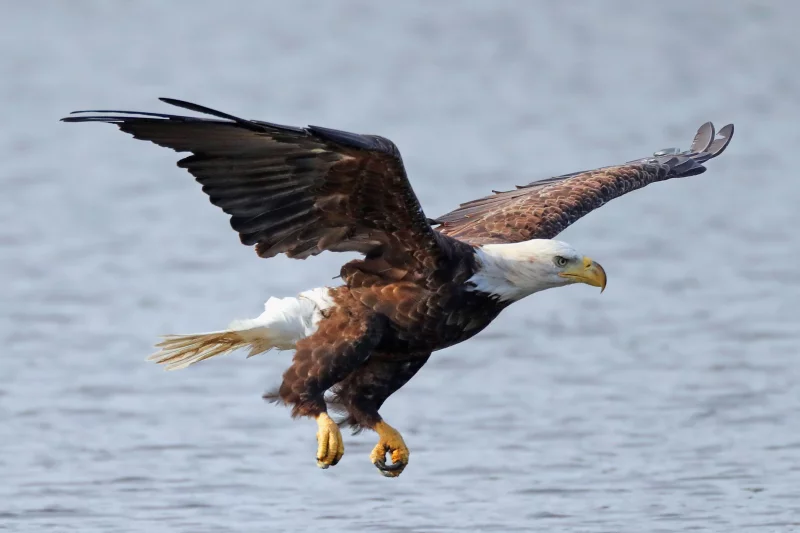The bald eagle has long been an iconic symbol of the United States, featured prominently on currency, documents, flags, stamps, government buildings, military uniforms, and more.
You might assume that the bald eagle is America’s national bird, but until recently, the fine print didn’t officially confirm it. That changed on Monday when the House of Representatives passed a bill to officially designate the bald eagle (Haliaeetus leucocephalus) as the national bird. The Senate had already passed the bill with bipartisan support in July, and now it only needs President Biden’s signature to become law.
“Today, we rightfully recognize the bald eagle as our official national bird — an honor long overdue,” said Rep. Brad Finstad, the Minnesota Republican who introduced the House version of the bill.
So why did it take so long for the eagle to gain official recognition, and how did this finally become a reality? Americans have one dedicated eagle enthusiast to thank for pushing the change.

The eagle has symbolized strength since ancient Rome, so it’s no surprise that it became a central figure in American iconography. After the U.S. was founded in 1776, three committees unsuccessfully attempted to design an official seal for the country. Eventually, Charles Thomson, the secretary of Congress, combined elements from all three proposals to create the Great Seal, featuring an eagle at the center, clutching an olive branch and arrows in its talons. The original design depicted a small, white eagle, but Thomson recommended replacing it with a bald eagle, a species native to North America. Congress adopted the design in 1782, solidifying the bald eagle as a symbol of the nation.
The species’ popularity has continued to grow, with bald eagles now featured on a range of patriotic merchandise, as school mascots, and even at major sporting events.

A Minnesota eagle enthusiast lobbied for the recognition
Preston Cook, a Minnesota man, was shocked to learn that bald eagles weren’t technically America’s national bird. Cook, 78, has devoted much of his life to studying and honoring the species.
“I saw a movie in 1966 called A Thousand Clowns, and it had one line in it: ‘You can’t have too many eagles,'” Cook told MPR News in November. “That inspired me. I left the theater thinking, ‘I want to collect eagles.'”
Over the years, Cook has amassed over 40,000 eagle-related items, from pins to paintings, housed at the National Eagle Center in Wabasha, Minn. One of his most treasured possessions is a set of eagle buttons from his military uniform in 1966.
Around 2010, while researching a book about bald eagles, Cook discovered there was no legislative record officially recognizing the bird as America’s national symbol. Alarmed, he wrote to the late Senator Dianne Feinstein of California, who sent staffers to the National Archives to conduct research. They confirmed his hunch: the U.S. had never legally designated a national bird.
Cook set out to change that. After years of lobbying lawmakers, he partnered with the National Eagle Center in 2023 to draft a simple bill. Securing support from Congress was difficult at first, as many assumed the bald eagle already had official status.
“It was a challenge in the beginning because people wouldn’t believe me,” Cook said. “But after they did their research, they came to the same conclusion: The bald eagle is not our national bird, and we don’t have a national bird.”
Minnesota Senators Amy Klobuchar and Tina Smith co-sponsored the Senate bill, and Minnesota Representatives Brad Finstad and Angie Craig introduced it in the House. It was no surprise that the bill gained traction in Minnesota, home to the second-largest bald eagle population in the U.S., after Alaska. As Klobuchar said, “We know a thing or two about eagles.”
Bald eagles had been abundant in the U.S. when they were chosen for the Great Seal in 1782, but their population dwindled over time. For decades, they were considered endangered, largely due to habitat loss, shootings, pesticide use, and collisions with vehicles and power lines.
The Bald Eagle Protection Act passed in 1940 made it illegal to kill, possess, or sell the birds. But the species faced new threats in the 1950s and ’60s, including the pesticide DDT, which caused eggshells to thin and break. By 1963, there were just 417 nesting pairs left in the lower 48 states.
Federal protections and the eventual banning of DDT in 1972 allowed the bald eagle population to recover. By 2007, the species was removed from the Endangered Species list.
Ed Hahn, communications director at the National Eagle Center, hopes the bald eagle’s recovery serves as an example for the management of other species, whether or not they are officially recognized.
“When we look at some of the issues facing natural resources today, we can look at our living national symbol, now our official national bird,” Hahn said. “It shows what we can achieve when we truly value something.”
